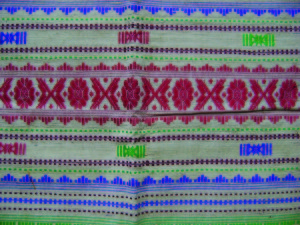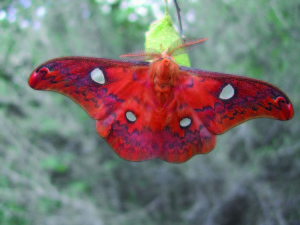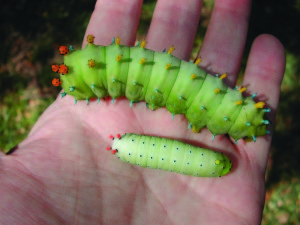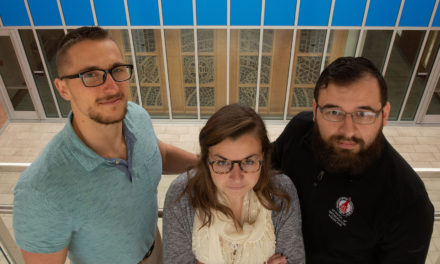Dr. Richard Peigler, professor of biology at the University of the Incarnate Word (UIW), has been an entomologist since he was three years old and collected insects in jars. A passion for science, nature, and insects – particularly moths – led Peigler to a world of ethnographic treasures he has shared across the globe through articles, various textile pieces, and books. Most recently in 2013, he co-authored the book, “Eri Silk: Cocoon to Cloth,” published by Bishen Singh Mahendra Pal Singh.
“I have been gathering information for 15 years for an encyclopedia type book on wild silks of the world [produced from wild silkmoths and silkworms],” he said. “I also collect wild silk textiles from places such as India, Nigeria, China, Ethiopia, and Madagascar, to contribute to institutional collections.”
It was during a quest of purchasing eri silk scarves for a collection when Peigler met Kiran Badola, a textile designer and fellow co-author of the book. The two discovered they had knowledge of eri silk that complimented each other.
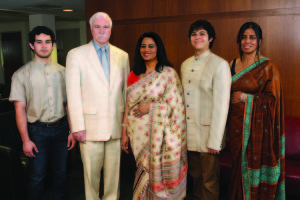
Pictured L-R: Ricardo Mata, biology student; Dr. Richard Peigler; Dr. Lopita Nath; Arthur Barrera; and Dr. Neeta Singh, professor of nutrition. Mata wears a shirt from India of tasar silk; Peigler a suit of tussah silk from China and a shirt and tie of eri silk from India; Nath a mekhela chaddar of muga silk from Assam, India; Barrera a fagara silk jacket from Java, Indonesia; and Singh a sari made of eri silk from India.
“It was not difficult for me to contribute text and images for the book,” Peigler said. “I took the chapter on eri silk from my larger encyclopedia book project and selected what I wanted to share.”
Peigler said his agenda is to gather and distribute as much information as possible on the silks and textiles, and to get them preserved in institutional collections, not only at UIW, but at universities and museums across the country. He explained that a lot of the wild silk textiles he has been collecting are being lost through globalization, cultural change, and habitat destruction.
“I feel very passionate about preserving these textiles so it is very gratifying work,” he said. “These pieces of material culture from Indigenous Peoples are truly ethnographic treasures. Not all students have access to see these types of things so I send them all over for teaching purposes, exhibits, or even just to be safe and stored away.”
Peigler has shared textile pieces with universities near and far, from his alma mater at Clemson University in South Carolina, to Montana State University, the University of Wyoming in Laramie, Texas A&M, and he once assembled an exhibit in UIW’s own Mabee Library. A few years ago, he also installed a textile display at the UIW AT&T Science Center in the showcase in the hallway focused on fair trade and poverty alleviation, with help from Sr. Martha Ann Kirk, CCVI, professor of religious studies.
Peigler said Incarnate Word has supported his research through many avenues. In 2003, UIW published his book, “A Revision of the Silkmoth Genus Samia.” He has also found it beneficial to include his colleagues and students in his work when the opportunity presents itself.
“Dr. Lopita Nath grew up with these wild silks in her home state of Assam, India,” Peigler shared. “She has pieces in her family, and has modeled pieces for my book such as the Mekhela Chaddar created from muga silk, one of the traditional dresses in her culture.”
Nath, associate professor of history at UIW, explained the muga is found naturally only in Assam, which has an exclusive patent for the silk. “I have grown up wearing muga,” she said. “As such, it was fascinating for me that a professor at UIW was doing research on that and knew so much about a fabric that is indigenous to a remote state in India so far away from San Antonio.”
Nath said being from Assam, she wanted to take the opportunity to model the textiles in the forms they are worn in her home state. “It made me feel close to home in a foreign country,” she said. “I also think it is beneficial for our students to see the different textiles and the cultures that are associated with them.”
Arthur Barrera, biology major at UIW, took Peigler’s entomology course and modeled a scarf and vest for his recent book on eri silk. “Dr. Peigler showed me some textiles during an office visit and when he told me what they were made of I was immediately interested,” Barrera said. “Many of the silks were hand woven with their own intricate designs. It made me reflect on how much hard work and creativity each silk must have taken.”
Peigler said his collections and sharing of textiles is a project that truly took on a life of its own from a unique angle. “I am most interested in the ecology and taxonomy of moths, and the silks are a spin off to this topic,” he said. “Most researchers who study silks and textiles focus on one particular country, but no one seems to have the big picture of the silks from all over the world as I have captured.”
Peigler said he hopes to continue leaving a legacy to preserve these important cultural textiles for future generations.
To learn more about Peigler’s wild silk textiles in the Mississippi Entomological Museum, click here!



